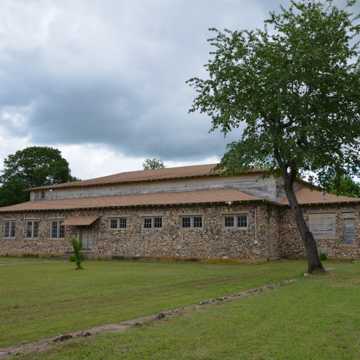Bruno, an isolated community fifteen miles from the nearest railroad, is significant for its school’s impressive program and advancement in agricultural education, an outcome of the federal Smith-Hughes National Vocational Education Act of 1917. In 1921, J. B. Ewart, a graduate of Arkansas State University, came to this isolated community to teach vocational agriculture in the local school. Two years later, the school’s students organized the Lincoln Aggie Club, an embryo of what led to the organization in 1927 of the national association of the Future Farmers of America. In 1926, twenty-six of the school’s students constructed a wooden gymnasium and clad it with rubble stone. Known as Aggie Hall, the large rectangular building has a hipped roof with a hipped-roof monitor along the ridge line and operable clerestory windows to provide light and air to the interior. The Smith-Hughes Act and later New Deal programs enabled the Bruno School complex to expand into one of the largest agricultural programs in the state. By 1935, the Aggie Workshop, a larger and more complex facility, was added. The school closed in the 1970s, and although Aggie Hall has been repurposed, the building remains a notable example of the use of the plentiful indigenous fieldstone of the Ozark Mountains.
You are here
Aggie Hall, Bruno School
If SAH Archipedia has been useful to you, please consider supporting it.
SAH Archipedia tells the story of the United States through its buildings, landscapes, and cities. This freely available resource empowers the public with authoritative knowledge that deepens their understanding and appreciation of the built environment. But the Society of Architectural Historians, which created SAH Archipedia with University of Virginia Press, needs your support to maintain the high-caliber research, writing, photography, cartography, editing, design, and programming that make SAH Archipedia a trusted online resource available to all who value the history of place, heritage tourism, and learning.


